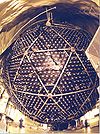- Neutrino Factory
-
The Neutrino Factory is a proposed particle accelerator complex intended to measure in detail the properties of neutrinos, which are extremely weakly interacting fundamental particles that can travel in straight lines through normal matter for thousands of kilometres. Up until the 1990s, neutrinos were assumed to be massless, but inconsistent experimental results from searches for solar neutrinos (those produced in the Sun's core) and others, indicated that the neutrino does in fact have a very small mass (see Solar neutrino problem).
Contents
Function
The Neutrino Factory will create a fairly focused beam of neutrinos at one site on the Earth and fire it downwards, probably in two beams emitted in different directions from a racetrack shaped underground muon storage ring, until the beams resurface at other points. One example could be a complex in the UK sending beams to Japan (see Super-Kamiokande) and Italy (LNGS). The properties of the neutrinos will be examined at the remote sites to determine how neutrinos evolve over time. This will provide information about their masses and weak interaction properties.[1]
The project is currently in the conceptual design stage. An international "Scoping Study" was completed in 2007 and an international effort to write a design report has now begun.
Many new technologies are being pioneered for this experiment, including the use of liquid metal jets as a pion production target, under test in the MERIT experiment, the use of Fixed Field Alternating Gradient (FFAG) accelerators, under test in the EMMA experiment, and liquid hydrogen energy reduction cavities for reducing the divergence in the muon beam during the intermediate stages.
Associated design efforts
International Design Study
The International Design Study seeks to present a design report for the Neutrino Factory that details the physics performance, schedule and costs by 2012. The study will include contributions from all regions in a combined Reference Design Report.[2]
UK Neutrino Factory
There is a United Kingdom Neutrino Factory group.[3][4]
US Muon Collider collaboration
A "much more complete" effort from the USA, including the "Feasibility Studies", which are the most detailed engineering studies yet done (as of 2005). The Muon Collider is a project even more ambitious than the Neutrino Factory, using the unstable intermediate particles (muons) that produce neutrinos as the input to a very high-energy collider ring, aiming to reach higher concentrations of energy than even the LHC (operations start 2007) or ILC (in design phase) experiments.
European Neutrino Group
CERN did a design study a few years ago, before effort moved onto the LHC. Activities in Europe continue with meetings and involvement in international experiments and collaborations.
Japanese design
This is based on an unusual type of accelerator called an FFAG that combines elements from the cyclotrons of the 1950s with modern automated magnet design processes, and new magnetic alloy radiofrequency accelerating gaps. The main advantage of these is that the magnetic fields are fixed and do not have to be synchronised to the beam in any way, yet the beam naturally moves into regions of higher field as its energy increases, allowing for very rapid acceleration without the difficulties found in very rapid-cycling synchrotrons.
References
- ^ https://www.ids-nf.org/wiki/FrontPage/GeneralInfo
- ^ International Design Study
- ^ UK Neutrino Factory Homepage
- ^ MUON1 distributed computing project for design work on the UK device
Other links & projects
Neutrino detectors, experiments, and facilities Discoveries 
Operating Construction Retired Proposed Cancelled See also Categories:- Particle physics facilities
- Neutrino observatories
Wikimedia Foundation. 2010.
